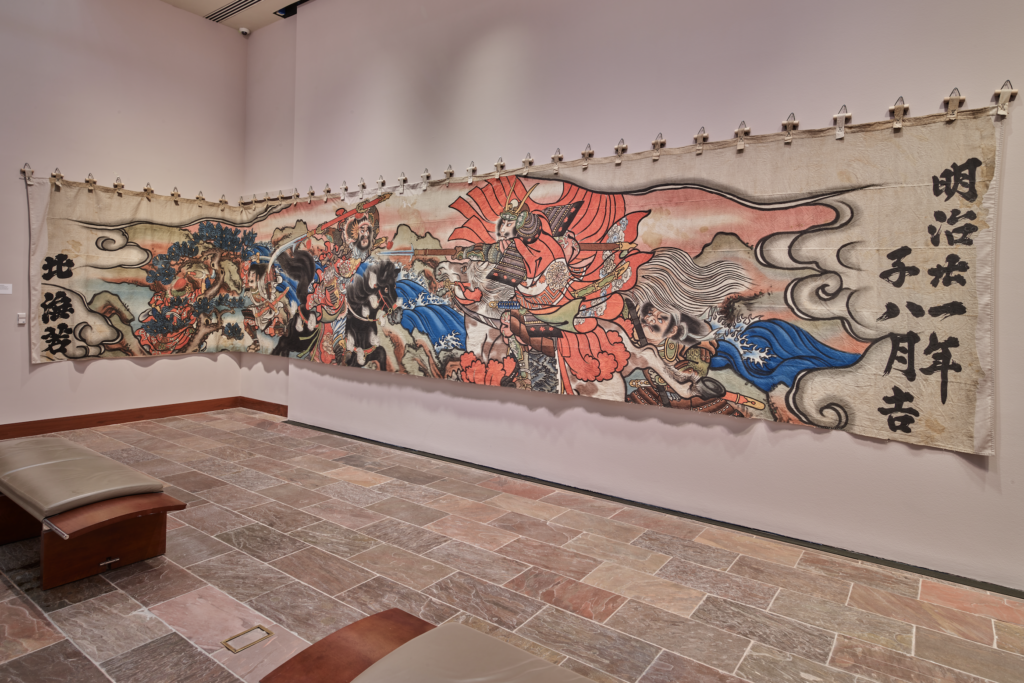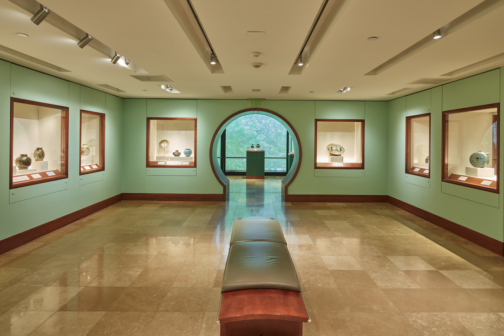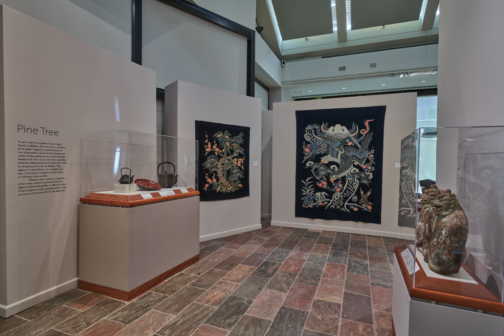A sacred ceramic box nearly three feet tall and two feet wide sits encased in a glass tube in the center of the room. The porcelain finish illuminates the sapphire-blue lotus flowers carved into the sides of the charcoal grey base. The lid is designed to look like a traditional Okinawa roof, with two handles that look like half-dragon, half-fish creatures that are worn with use.
This 19th century urn welcomes you into the Crow Museum of Asian Art’s newest installation, Japan, Form & Function: The Montgomery Collection. For the next year, the Crow Museum will dedicate over 11,000 square feet across six galleries to the exhibit. Only a portion of Jeffery Montgomery’s 1,100-piece collection was brought to Dallas; the 248 works span from 5,000 BCE to the mid-20th century. The collection will be free to the public through April 14, 2024.
Curated by Luigi Zeni, this collection is a journey across the country that begins in the south with the Okinawan archipelago. The Okinawan urn, which now sits empty, is only one stunning piece from the collection. Each gallery takes you through generations, from pots and jugs from the Kyushu region, other jugs created around 2,000 BCE, paper kimonos, and a variety of deities and good luck charms.
Montgomery first began collecting in 1955 at the age of 18 during a solo trip to Japan. He says he’s guided by gut feeling when acquiring new pieces. “In the beginning I had no instruction I was going by [my heart]. I moved, I looked, and I listened, and I purchased that which I felt. It just happened. I don’t know how, and I don’t know why.”
Ceramics are one of Montgomery’s favorite things to collect, which is evident throughout the museum. “Ceramics in Japan are as important as paintings in the Western world,” Montgomery says. Reminiscent of the exhibit’s name, the function of the object is just as important as the form. “There was never a comparison about what was beautiful and what was not. It is what it is. It’s important to know that it is what is.”
In the back corner of the museum, past all the statues and ceramics, hang a pair of breathtaking banners. The 32-foot long banners take up three of the four walls in this gallery. They depict two different battles, with soldiers who are detailed with embroidered kimonos and painted in vibrant reds, blues, and yellows. Thanks to the open space at the Crow Museum, this is the first time one of the banners has ever been shown. Montgomery said it’s the first time he has seen it fully opened.
Montgomery often displays the collection inside his own home; one corner of the museum was designed to replicate his lakeside residence. A jade tapestry hangs on lavender-colored walls with bamboo sprouting up the fabric. Floating shelves on each side display a ceramic cat, bowls, and plates. “My wife once said to me, many years ago, she said ‘can’t you just buy a vase for 20 Swiss francs instead of thousands?’”
The Mingei Movement heavily inspired Montgomery and takes up a generous portion of the collection. Mingei, in short, means Japanese folk art. It is a portmanteau of “minshu,” which means common people, and “kogei,” which means craft. The movement occurred in the 1920s and focused on the aesthetic beauty and simplicity of everyday objects in objection to the industrialization of Japan. The collection features work from famous Mingei artists like Bernard Leech, Kawai Kanjiro, and Hamada Shoji.
This will be the 35th exhibition of the collection, which has traveled across the globe to London, Zurich, New York, Switzerland, and now, Dallas. Montgomery never thought of himself as a collector, but rather a keeper of knowledge and culture. “I never thought of what I was doing as an investment,” Montgomery says. “I was just thinking of a culture and as time went by, I thought, ‘well, culture is really for the world, isn’t it?’ It’s for whoever appreciates it.”
Get the FrontRow Newsletter
Author










